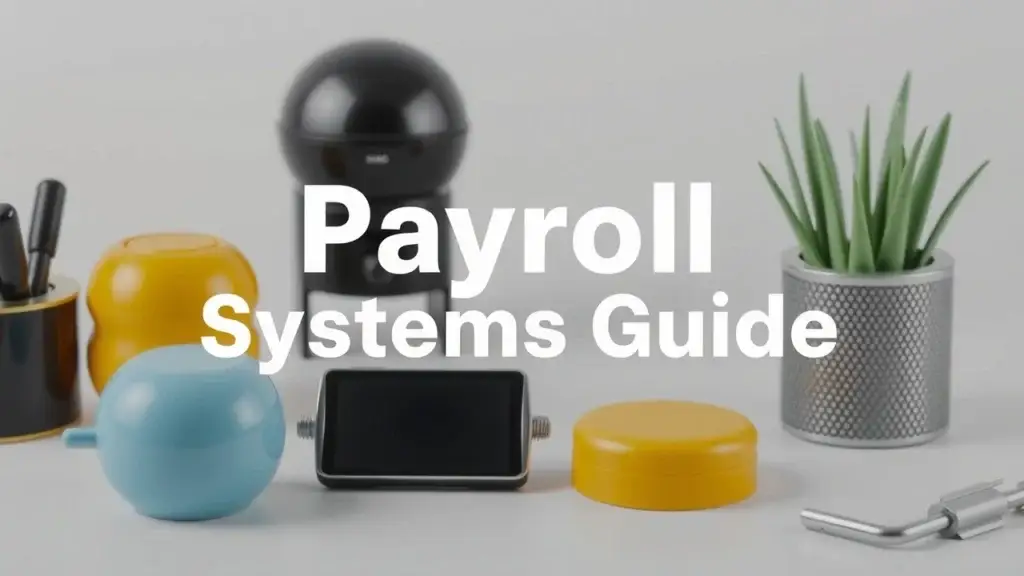Types of payroll systems range from simple spreadsheets to complex cloud-based solutions. This guide helps you choose the right system for your business needs, covering features, benefits, and different payroll methods.
What Is a Payroll System?

A payroll system is a software tool that helps businesses pay their employees. It makes the job of calculating wages easier and takes care of taxes and deductions for benefits like health insurance. The main parts of payroll systems include:
- Wage calculation
- Tax calculation
- Deduction management
- Payroll processing
There are different types of payroll software:
- In-House Payroll: Businesses manage payroll using their own resources.
- Cloud-Based Payroll: This type allows access to payroll services online, without needing much hardware.
- Payroll Outsourcing: Companies hire third parties to handle payroll tasks.
Each option has unique features that can fit different business needs.
Why Choosing the Right Payroll System Matters for Businesses?
Picking the right payroll system is really important for several reasons:
- Payroll Efficiency: A good system saves time and reduces errors in calculations.
- Payroll Accuracy: Correct calculations mean employees get paid correctly and on time, which helps keep morale high.
- Legal Compliance: Following federal and state rules about paying employees is key; failing to do so can lead to fines or legal troubles.
Using a weak system can create risks like wrong wage payments or missed tax filings, which can cost businesses money in penalties. By understanding these points, business owners can choose a payroll solution that fits their needs while keeping them compliant with laws.
Types of Payroll Systems Explained
In-House Payroll Systems
In-house payroll means that a business handles its own payroll internally. This involves dedicated personnel who know how to manage payroll calculations, employee data, and taxes.
Tools Required
To run an in-house payroll system effectively, businesses need specific tools. Common software options include QuickBooks Desktop or other accounting programs that work well with time and attendance systems. Plus, a strong IT setup is needed for security and efficiency.
Benefits
The main advantage of an in-house payroll system is having full control over data and processes. Businesses can customize their payroll systems to fit their unique needs. This can lead to better payroll efficiency and even save money since there are no outsourcing fees.
Drawbacks
However, there are some downsides. Initial costs for software and hardware can be high. Also, businesses depend on their internal expertise. If key staff leave or make mistakes, it could lead to payroll errors that affect employee satisfaction.
Outsourced Payroll Services
Outsourced payroll services involve hiring companies like ADP or Paychex to manage payroll for you. These services help reduce the workload for small businesses.
How Does Outsourcing Work?
When a company uses outsourced payroll services, it gets comprehensive help with everything from calculating wages to filing paperwork with the government. Providers take care of complex tasks while ensuring everything is legal.
Benefits
Outsourcing has many perks. You gain access to experts who know about taxes and compliance laws—knowledge that many small businesses don’t have in-house. This helps relieve pressure on HR staff so they can focus on more important business functions instead of paycheck tasks.
Drawbacks
Yet, there are some concerns as well. Outsourcing can limit control over operations, and sensitive data privacy may be at risk compared to doing it yourself. Additionally, some service providers might charge hidden fees that could catch you off guard.
Cloud-Based Automated Software Solutions
Cloud-based automated software solutions provide a modern way to manage payroll online. You can access these systems from anywhere with an internet connection, making them super flexible for businesses.
Examples Including Gusto Integrations
Many cloud systems come with features like Gusto integrations that help improve efficiency across different parts of your organization. These tools allow for better tracking of hours worked and automatic generation of paychecks without needing constant manual input.
Benefits
Accessibility is a big plus! Users can log in anytime from anywhere with internet access. Automatic updates keep you compliant with the latest laws while also offering improved security against fraud targeting your sensitive information stored online.
Drawbacks
Still, relying on the internet comes with risks. If there’s an outage, it could disrupt your business operations badly! Also, using online platforms may expose your business to certain security risks that need careful thought before diving in completely.
Specialized Payroll Systems: Industry-Specific Solutions
Overview of Specialized Payroll Systems
Specialized payroll systems are made for different industries that have special pay rules and laws. These systems help businesses handle tricky tasks like figuring out wages, keeping track of compliance reports, and managing tax deductions. For example, the construction industry needs to track hours spent on different jobs, while healthcare organizations often deal with various pay rates depending on roles or certifications.
Industry-specific solutions make payroll work easier by automating many tasks that can take a lot of time if done by hand. They also help companies follow local labor laws, which can change a lot from one industry to another. By using specialized payroll software, businesses can make fewer mistakes in wage calculations and keep accurate records needed for audits or inspections.
Examples of Specialized Systems and Their Features
Many industries use different kinds of specialized payroll systems to solve their specific issues:
- Construction: Construction payroll software offers job costing features and project-based reporting.
- Healthcare: Healthcare payroll management includes credential tracking and shift differentials.
- Retail: Retail payroll systems help with commission management and scheduling for hourly workers.
- Transportation: Transportation payroll solutions provide mileage tracking and overtime calculations.
Each system has features that match the industry’s needs. For instance, construction payroll software often includes tools to manage costs across multiple projects effectively.
Pros and Cons of Using Specialized Payroll Systems
Using specialized payroll systems comes with some clear benefits but also a few downsides:
Benefits:
- Efficiency: These systems automate complex wage calculations unique to the industry.
- Compliance: They help companies stick to legal standards relevant to their sector.
- Customization: Businesses can choose features that fit their specific needs.
Drawbacks:
- Cost: Specialized solutions tend to be pricier than standard options because of customization.
- Complexity: Staff may need extra training to get used to these advanced functions.
In short, while specialized payroll systems offer significant advantages in managing complex pay structures and ensuring compliance with regulations, they might also bring challenges such as higher costs and a learning curve compared to regular payroll options.
Cost Comparison of Payroll Systems
Cost Breakdown: In-House Payroll
In-house payroll means handling payroll tasks within your company. This can lead to higher costs because you need a team and resources. Here are some key points:
- Payroll Software: You need good payroll software for smooth processing. The price changes based on features and the number of employees.
- Dedicated Personnel Costs: If you hire people just for payroll, it adds up. Think about their salaries, benefits, and training costs.
- IT Infrastructure Costs: You’ll also need IT support for things like servers and data protection, which can be pricey but is really important.
In-house payroll gives you more control but can get expensive fast due to these needs.
Cost Breakdown: Outsourced Payroll
Outsourced payroll means hiring outside companies to manage payroll tasks. This option often makes budgeting easier:
- Per-Employee Costs: Most payroll services charge per employee each pay period. This helps your expenses match your workforce size.
- Additional Services Fees: Some providers might have extra charges for things like tax filing or compliance help. It’s smart to check these fees before you choose a service.
Outsourcing can lessen the workload on your team but think carefully about the total costs compared to potential savings on staff.
Cost Breakdown: Cloud-Based Payroll
Cloud-based payroll systems let you access everything online without needing a lot of hardware:
- Subscription Fees: Most cloud services use monthly or yearly fees that depend on what features you use and how many employees you have.
- Add-On Costs: If you want extra features, like advanced reporting or integrations with other systems, there could be more charges.
These flexible options work well for small businesses that want affordable solutions without losing important features or support.
Cost Breakdown: Specialized Payroll Systems
Specialized payroll systems focus on specific industries like construction or healthcare where pay structures vary:
- Industry-Specific Pricing Features: These systems may cost more at first due to their unique functions that meet specific regulations in those industries.
Businesses should think about whether these special features are worth the extra money compared to general software that might work just fine for them.
Legal Compliance and Best Practices
Key Legal Compliance Requirements
Following the rules for legal compliance is very important for businesses in different areas. Payroll compliance means understanding and following payroll laws, like federal, state, and local payroll taxes. Each level of government can have different regulations affecting how employees get paid. Businesses need to keep up with changes in these laws to avoid fines and treat their employees fairly. Checking for updates from the IRS or local tax offices regularly can help maintain compliance.
Data Security and Privacy
Keeping sensitive employee information safe in a payroll system is super important for trust and legal reasons. Companies manage lots of personal data, including Social Security numbers, bank details, and salary info. If this data gets leaked, it could lead to identity theft or financial losses for employees and hurt the company’s reputation.
To protect this data well, businesses should use strong security measures. For example, they can use encryption during data transfer and storage. Access control is also key; only people who are allowed should see sensitive information. Plus, companies must follow rules like GDPR in Europe or CCPA in California to be open about how they gather and use employee data.
Regular training on privacy best practices can also help staff understand dangers like phishing scams that try to steal sensitive information.
Payroll Accuracy and Timeliness
Making sure payroll is accurate is key to avoiding mistakes that might upset employees or lead to fines from regulatory bodies. Accurate wage calculations depend on processing hours worked correctly and figuring out overtime pay rates and deductions for benefits like health insurance or retirement plans.
Some common mistakes include not tracking overtime properly or using outdated tax rates when calculating federal payroll taxes. To avoid these issues:
- Use automated payroll software that works with timekeeping systems.
- Regularly check deduction calculations against current laws.
- Have a clear process for handling adjustments related to bonuses or commissions right away.
Paying employees on time is just as crucial; late wages can frustrate workers and break labor laws depending on where you are.
Regular Audits and Internal Controls
Regular audits are an important part of keeping a good payroll system running smoothly. They help catch problems before they grow into bigger issues like fraud or breaking laws about paying employees correctly.
Internal controls are procedures designed to protect assets while making sure all reports are accurate across the organization—especially when it comes to managing employee compensation without making too many errors that might cause problems later.
Creating strong internal controls might mean dividing duties between people who prepare checks and those who approve them. It also includes setting up an audit trail to track every transaction processed through your payroll system.
Choosing the Right System: A Step-by-Step Guide
Assessing Your Business Needs
When picking a payroll system, start by looking at your business needs. Think about how big your company is—are you a small, medium, or large business? Small businesses usually need simple payroll systems that do basic tasks. On the other hand, medium and large companies might need more advanced options to manage many employees and complex pay rates.
Check what software you already use. If you have specific HR or accounting tools, find payroll systems that can work with them easily. Your budget also matters; make sure the system you pick is affordable but still covers your must-haves.
Also, think about how complex your payroll processes are. If you have things like different pay rates or various tax rules in different areas, choose a system that can handle those needs well.
Evaluating Payroll System Options
After understanding your needs, look at different payroll systems available. It’s important to do a payroll system comparison now. Make a list of features that are most important for your company. This could include automated tax calculations, direct deposit options, tracking compliance, and easy-to-use designs.
When deciding on the best payroll system for your company’s growth, consider both cloud-based options and traditional systems installed on-site. An integrated payroll solution might be useful if you want departments like HR and finance to share information without manual errors.
Making Your Decision
Once you’ve compared different systems using your feature list, think about their pros and cons before choosing which payroll system fits best for you. Look at how easy they are to use compared to what features they provide—sometimes easier systems may not have all the features but are simpler to operate.
Think about future growth too; pick a solution that can expand as your business grows instead of one that might become outdated quickly because of changing needs or regulations tied to payroll processing solutions.
Implementing Your Chosen System
Setting up your selected payroll system requires planning around choosing the right vendor first and then organizing training sessions for users in your company who will use it often.
Ongoing maintenance is key; set clear rules for updates so that compliance is always met even with changes in employment laws. Connecting HR software with accounting tools helps improve overall efficiency while giving employees access to their pay information online—a feature that many workers expect these days.
Don’t forget about data privacy during this setup phase; protecting sensitive employee details should be a top priority throughout every step from setup to regular use.
Frequently Asked Questions (FAQs)
What are the common types of payroll systems?
Businesses use various payroll systems based on their needs. Common types include in-house payroll, outsourced payroll, cloud-based solutions, and specialized systems for specific industries.
How can I ensure payroll compliance with regulations?
To ensure compliance, choose a payroll system that updates regularly with federal and state laws. Regular audits and staff training help maintain compliance with payroll regulations.
What features should I look for in payroll software?
Key features include automation for tax calculations, integration with HR software, secure data management, and employee self-service options for easy access to pay information.
How do I choose the best payroll system for my small business?
Assess your business size and needs first. Consider factors like cost, required features, ease of use, and integration capabilities with existing HR or accounting software.
What are the costs associated with different payroll systems?
Costs vary by type. In-house payroll involves software and personnel expenses. Outsourced services charge per employee, while cloud-based options typically use subscription fees based on usage.
Additional Insights on Payroll Systems
Key Considerations for Payroll System Selection
- Payroll Efficiency: Look for automation features to minimize manual tasks.
- Data Security: Ensure strong security measures protect sensitive employee data.
- Integration Capabilities: Choose systems that integrate easily with existing HRIS or accounting software.
- Employee Portal Access: Provide employees with self-service access to view pay stubs and manage personal information.
Payroll Challenges in Different Industries
- Healthcare: Requires tracking varied pay rates and compliance with specific regulations.
- Construction: Needs job costing features to manage labor across multiple projects effectively.
- Retail: Must handle commissions and variable hourly rates efficiently.
Trends Impacting Payroll Systems
- Cloud Adoption: Businesses increasingly prefer cloud-based solutions for flexibility.
- AI Integration: AI helps streamline processes like tax compliance and error detection.
- Employee Experience Focus: Enhanced self-service options improve user satisfaction among employees.
Related Topics
- types of payroll software
- types of payroll services
- types of automated payroll systems
- types of specialized payroll systems
- types of payroll compliance software
- types of payroll processing solutions
- types of payroll mistakes
- types of payroll audits
- types of HR software
- types of accounting software



Types of Payroll Systems: A Complete Guide